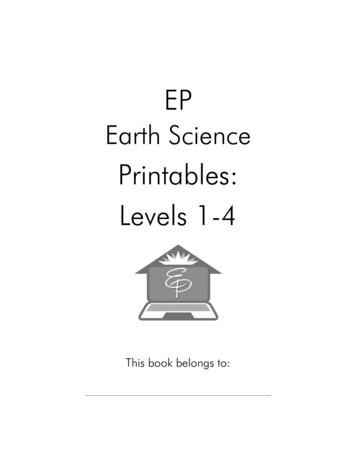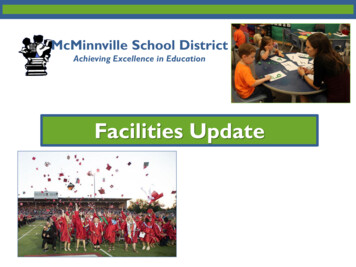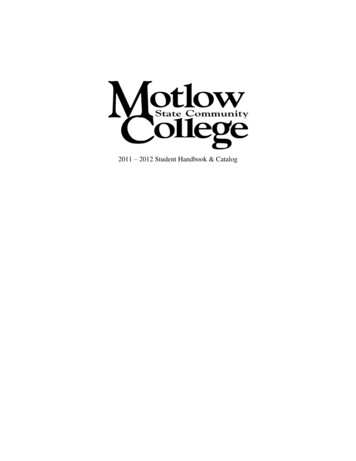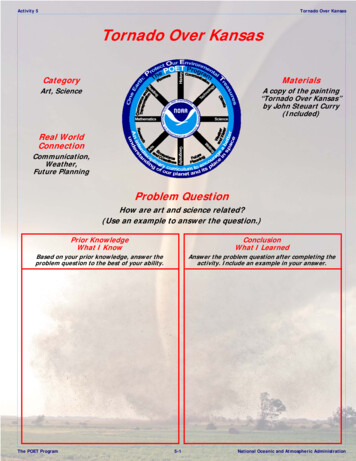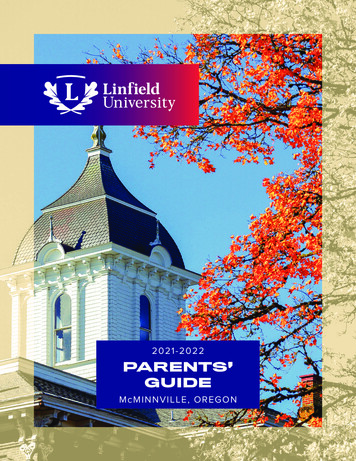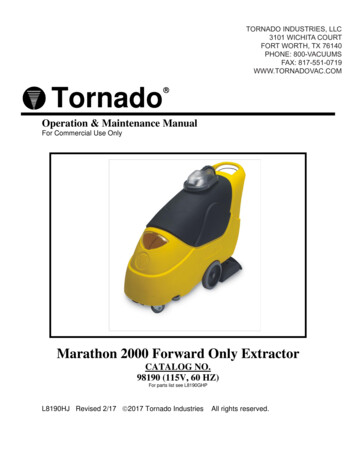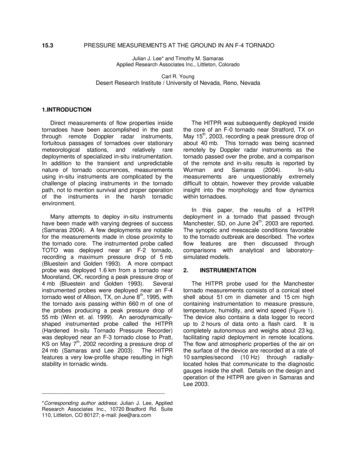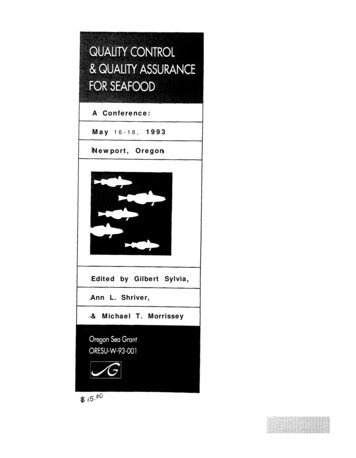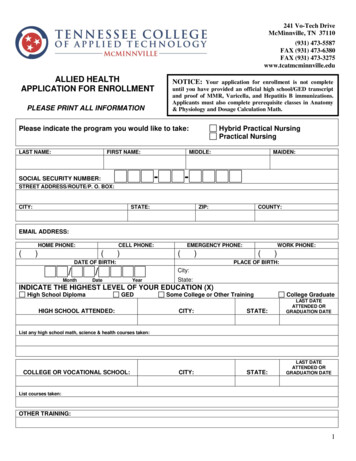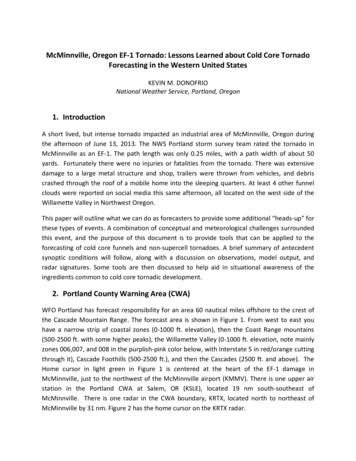
Transcription
McMinnville, Oregon EF-1 Tornado: Lessons Learned about Cold Core TornadoForecasting in the Western United StatesKEVIN M. DONOFRIONational Weather Service, Portland, Oregon1. IntroductionA short lived, but intense tornado impacted an industrial area of McMinnville, Oregon duringthe afternoon of June 13, 2013. The NWS Portland storm survey team rated the tornado inMcMinnville as an EF-1. The path length was only 0.25 miles, with a path width of about 50yards. Fortunately there were no injuries or fatalities from the tornado. There was extensivedamage to a large metal structure and shop, trailers were thrown from vehicles, and debriscrashed through the roof of a mobile home into the sleeping quarters. At least 4 other funnelclouds were reported on social media this same afternoon, all located on the west side of theWillamette Valley in Northwest Oregon.This paper will outline what we can do as forecasters to provide some additional “heads-up” forthese types of events. A combination of conceptual and meteorological challenges surroundedthis event, and the purpose of this document is to provide tools that can be applied to theforecasting of cold core funnels and non-supercell tornadoes. A brief summary of antecedentsynoptic conditions will follow, along with a discussion on observations, model output, andradar signatures. Some tools are then discussed to help aid in situational awareness of theingredients common to cold core tornadic development.2. Portland County Warning Area (CWA)WFO Portland has forecast responsibility for an area 60 nautical miles offshore to the crest ofthe Cascade Mountain Range. The forecast area is shown in Figure 1. From west to east youhave a narrow strip of coastal zones (0-1000 ft. elevation), then the Coast Range mountains(500-2500 ft. with some higher peaks), the Willamette Valley (0-1000 ft. elevation, note mainlyzones 006,007, and 008 in the purplish-pink color below, with Interstate 5 in red/orange cuttingthrough it), Cascade Foothills (500-2500 ft.), and then the Cascades (2500 ft. and above). TheHome cursor in light green in Figure 1 is centered at the heart of the EF-1 damage inMcMinnville, just to the northwest of the McMinnville airport (KMMV). There is one upper airstation in the Portland CWA at Salem, OR (KSLE), located 19 nm south-southeast ofMcMinnville. There is one radar in the CWA boundary, KRTX, located north to northeast ofMcMinnville by 31 nm. Figure 2 has the home cursor on the KRTX radar.
Figure 1: Portland, OR County Warning Area topography image (County Warning area outlined inblack). The Pacific Ocean is colored black. Image is elevation in kft with color table on top.Figure 2: Larger view of the Portland CWA (cyan outline, including coastal zones) with larger citieshighlighted. KRTX radar is located at the Red Home cursor. The state of Oregon is outlined in blue.
3. The synoptic and meso-scale environmentOn the morning of June 13, 2013, an upper level low pressure system was moving through thePacific Northwest. Figure 3 depicts the upper low position at 1200 UTC. The west half thePortland CWA was under NW flow aloft. At the surface, weak low pressure was analyzed justoffshore of the North Oregon Coast/Coast Range, resulting in S to SE surface winds in theWillamette Valley (Figure 4). The morning upper air sounding from Salem, OR (Figure 5)depicted fairly moist lower level conditions. Relatively weak speed shear was present, butdecent veering with height of the wind profile was shown. 850 mb winds were about 10 kt, and500 mb winds were less than 30 kt. Modest CAPE was analyzed (near 700 J/kg) and decent midlevel lapse rates in response to the cold upper level low can be seen in the 700-500 mb layer onthe upper air sounding along with 24 hr. temperature change drops in the mid-levels.Figure 3: Water Vapor Satellite image with 500mb Height (contour – green), 1200 UTC June 13 2013.Dry colors are in orange with grays and blues indicating more moisture.
Figure 4: Visible satellite with Mean Sea Level Pressure (contour – green) and surface observations incyan (1400 UTC June 13 2013)
Figure 5: 1200 UTC Upper-Air sounding, Salem, OR (KSLE). Winds at 850 mb were only 10 kt, with lessthan 30 kt at 500 mb.
Figure 6: 18Z NAM, 3 Hr forecast at 2100 UTC on June 13, 2013. Upper left is 500 mb vorticity (image)with 500 mb height (contour - white). Upper right is 1000-500mb thickness (image) with MSLPcontours and surface wind. Lower left is 250 mb windspeed (image) with 850 mb temperaturecontours and 850 mb wind. Lower right is 3 hr QPF (image) with Surface CAPE (contoured – yellow).4. Forecast and observed conditionsThe forecast (Figure 6 above) was for the upper low to slowly move to the east, keeping thewest side of the Portland CWA under northwest flow aloft, and still under the influence of coldair aloft. The upper level jet was digging on the back side of the low into Southern Oregon andthen back around the base of the trough into Idaho. The weak surface low was forecast tomove inland to the North Oregon Coast Range, with the NAM model showing south tosouthwest winds in the Willamette Valley. CAPE was forecast around 400 J/Kg. This forecastwas confirmed by the observed upper air (Figure 7) and surface charts (Figure 8). Analysis fromthe 2100 UTC RAP model (Figure 9) was consistent with the NAM forecast of 300-400 J/KgMixed-layer CAPE. The RAP analysis also indicated no CIN, weak 0-1 km Shear (5-10 kt), andweak to moderate 0-1 km shear (35 kt). The Pacific Northwest normally experiences plentifulshowers and isolated thunderstorms in this weather pattern.
Figure 7: Water Vapor Satellite with 500 mb Height, 2300 UTC June 13, 2013
Figure 8: Visible satellite and METAR observations at 2300 UTC, June 13, 2013. Home cursor in Red atthe location of the tornado.
Figure 9: RAP Thermodynamic and Kinematic Parameters, 2100 UTC June 13, 2013.
The McMinnville tornado occurred just before 0000 UTC of June 14, 2013, which is almostconcurrent with the KSLE upper air balloon launch. Figure 10 shows the 1800 UTC NAM BUFRforecast sounding for Salem, OR (KSLE) at 2300 UTC of June 13, 2013, while Figure 11 shows theKSLE upper-air sounding observed data at 0000 UTC of June 14, 2013. The NAM BUFR soundingwas depicting southwest surface winds, but the upper-air sounding was able to depict theadditional backing of the low level winds to southeast in response to the surface low along theNorth Oregon Coast Range. This further enhanced the directional shear. The natural terrain ofthe Willamette Valley often also constrains surface winds to southerly due to channeled flowbetween the Coast Range and Cascade Mountains. Surface winds at the McMinnville airport(KMMV) at the time of the tornado were indeed out of the southeast. Both images depict arather low LCL between 2,300 and 2,700 ft.Figure 10: 1800 UTC NAM BUFR 5 hr forecast, effective 2300 UTC June 13, 2013
Figure 11: KSLE 0000 UTC Upper Air Sounding, June 14, 20135. Radar Operations - Why is it hard to warn for these storms?Widespread showers were found across the CWA on the afternoon of June 13, 2013, with asignificant increase in activity during the mid-afternoon. There were numerous funnel cloudreports this afternoon as well. The McMinnville tornado was on the ground from about 2331UTC to 2337 UTC (4:31 PM PDT to 437 PM PDT). Spotter and social media video confirmed thepresence of a funnel cloud prior to the tornado touch down. Spotters along with the stormsurvey confirmed that debris continued to be lofted and thrown SE of the main tornado track asthe tornado lifted back to a funnel cloud.A few common questions in these situations are: Why was there no warning? Why is it so hardto detect these types of tornadoes on radar? These storms have no visible hook echo to themas typically observed in classic supercell tornadoes. They also form and dissipate fairly quickly,and exhibit little or very weak rotation. There are several possible answers to these questions,and we will explore this a bit more.
Here is a quote from Baumgardt and Cook (2006) that explains these challenges in a bit morescientific detail: “Tornadoes that occur prior to the formation of radar-detected mesocyclonespresent many problems to the operational forecast community. This type of tornadogenesisusually occurs within minutes of, or prior to, the first detection of radar reflectivity echo(Burgess and Donaldson 1979; Roberts and Wilson 1995). Often, radar signatures of the largertornado cyclones are quite weak during tornado time, yielding little or negative lead time forwarnings issued to the public. Because of this difficult sampling issue, higher situationalawareness of the miso- to mesoscale environment conducive to this non-mesocyclonetornadogenesis (NMT) process can provide positive impacts to the warning mission byincreasing information flow to the public on possible threats.”The next set of figures (12-21) depict Radar Reflectivity and Radar Velocity from KRTX from2324 UTC (4:24 PM PDT) to 2344 UTC (4:44 PM PDT). McMinnville is located 31 nm southsouthwest from KRTX, and the lowest elevation slice (0.5 deg) intersects the storm around4,000 ft. MSL. The elevations sampled by each of the next lowest 3 slices (0.9 deg, 1.3 deg, 1.8deg) are 5,200 ft. MSL, 6,500 ft. MSL, and 8,000 ft. MSL respectively.The McMinnville tornadic storm was quite possibly the strongest storm of the day. The tornadowas also stronger than many cold core tornadoes, which are typically weaker EF-0 tornadoes withan even more benign signature. The maximum reflectivity of the storm was 64 dBz shown inFigure 14 on the 1.3 slice at 2328 UTC. There was a notable increase in reflectivity from the2324 to 2328 UTC volume scans, and perhaps a weak echo region on the 2328 UTC 0.5 degslice. In the 2333 UTC volume scan, reflectivity was already decreasing in the scans at 0.9 degand higher, but did increase in the 0.5 deg scan. This was the time of EF-1 damage. The nexttwo volume scans showed a continued weakening of the storm. The observed freezing level onthe SLE 6/14/2003 0000 UTC sounding was 6,292 ft., just below the elevation sampled by the1.3 deg slice. Echo tops on the storm peaked at 16,000-18,000 ft., close to or slightly coolerthan the observed -20C level ( 16,000 ft.). Therefore, these storms were very low-topped. Echotops on classic tornadic supercells can reach 40,000-60,000 feet.One key feature that forecasters look for in a potential tornadic storm is rotation. On this day,numerous showers exhibited some form of weak rotation. The maximum gate-to-gate shearobserved by McMinnville tornado was only 18 kt on the 0.5 deg slice (2324 UTC – 4000 ft. MSL)and 20 kt on the 0.9 deg slice (2333 UTC – 5200 ft. MSL). When you look at the velocity images,you will notice a couplet of outbound velocities in red next to inbound velocities in green. Thisfeature represents cyclonic rotation since you are looking down radial, and it had somecontinuity with height. There was some tightening of this couplet, but it did maintain itssignature for a few volume scans before a significant drop off from the 2337 UTC and 2342 UTCvolume scans when the tornado lifted back to a funnel cloud.
Figure 12: KRTX Radar Reflectivity: 2324 UTC. Note: Increasing elevation of radar scan clockwise fromupper left. Upper left 0.5 deg, Upper right 0.9 deg, Lower right 1.3 deg, Lower left, 1.8 deg. Units indBz.
Figure 13: KRTX Radar Velocity: 2324 UTC. Note: Increasing elevation of radar scan clockwise fromupper left. Upper left 0.5 deg, Upper right 0.9 deg, Lower right 1.3 deg, Lower left, 1.8 deg. Outboundvelocities in red, inbound velocities in green. KRTX radar is to the north-northeast of the tornado.Units are in kt.
Figure 14: Radar Reflectivity: 2328 UTC. Note: Increasing elevation of radar scan clockwise from upperleft. Upper left 0.5 deg, Upper right 0.9 deg, Lower right 1.3 deg, Lower left, 1.8 deg.
Figure 15: Radar Velocity: 2328 UTC. Note: Increasing elevation of radar scan clockwise from upperleft. Upper left 0.5 deg, Upper right 0.9 deg, Lower right 1.3 deg, Lower left, 1.8 deg.
Figure 16: Radar Reflectivity: 2333 UTC. Note: Increasing elevation of radar scan clockwise from upperleft. Upper left 0.5 deg, Upper right 0.9 deg, Lower right 1.3 deg, Lower left, 1.8 deg. This is the timethat best coincides with the tornado EF-1 damage, with touchdown in between the previous scan andthis scan of the radar.
Figure 17: Radar Velocity: 2333 UTC. Note: Increasing elevation of radar scan clockwise from upperleft. Upper left 0.5 deg, Upper right 0.9 deg, Lower right 1.3 deg, Lower left, 1.8 deg. This is the timethat best coincides with the tornado EF-1 damage, with touchdown between the previous scan andthis scan of the radar.
Figure 18: Radar Reflectivity: 2337 UTC. Note: Increasing elevation of radar scan clockwise from upperleft. Upper left 0.5 deg, Upper right 0.9 deg, Lower right 1.3 deg, Lower left, 1.8 deg.
Figure 19: Radar Velocity: 2328 UTC. Note: Increasing elevation of radar scan clockwise from upperleft. Upper left 0.5 deg, Upper right 0.9 deg, Lower right 1.3 deg, Lower left, 1.8 deg.
Figure20: Radar Reflectivity: 2342 UTC. Note: Increasing elevation of radar scan clockwise from upperleft. Upper left 0.5 deg, Upper right 0.9 deg, Lower right 1.3 deg, Lower left, 1.8 deg. The tornado hadlifted back to a funnel cloud at this point.
Figure 21: Radar Velocity: 2342 UTC. Note: Increasing elevation of radar scan clockwise from upperleft. Upper left 0.5 deg, Upper right 0.9 deg, Lower right 1.3 deg, Lower left, 1.8 deg. The tornado hadlifted back to a funnel cloud at this point.
6. Situational awareness toolsWe learned from the radar analysis that it will be hard to warn with confidence for tornadoesthat form in non-supercellular environments such as in this case, without additional reports orvideo. The Portland CWA has many days where there are widespread post-frontal showers. Thefeatures for a potential “cold-core funnel” or tornadic cell are often present (quickintensification, high Z, some rotation), but these features are usually very subtle. What we cando is be aware of the ingredients that come together on these days, and give a “heads-up”message such as a Special Weather Statement earlier in the day. On the day of the McMinnvilletornado, the first funnel cloud report was at 1:15 PM PDT. We did not hear about it until afterthe fact. This report may have been a key piece of information that could cue forecasters to thepotential for cold core tornadoes. Seek out reports from storm spotters or social media whenyou see strong showers. The staff monitoring this storm did call spotters and were active onsocial media, and there was no clear evidence of a funnel cloud or tornado on this storm beforethe initial reports came in on Twitter.One potentially useful tool in these situations is illustrated in Figure 22, which shows how toaccess a research based parameter found on the Storm Prediction Center’s (SPC) Mesoanalysispage called the Non-Supercell Tornado Parameter (NST). This parameter expands upon theEnhanced Stretching Potential (ESP) parameter available in AWIPS, a tool that tends to showbroad areas of potential low level stretching. The ESP is discussed in detail in Davies (2003). Thefollowing is an excerpt that you can read by clicking the question mark (?) next to the name ofthe NST parameter on the webpage shown in Figure 22. The following except is from anabstract by Dan J. Baumgardt and K. Cook at the 23rd Conference on Severe Local Storms inNovember 2006:“Research continues to increase on radar and environmental aspects of the non-mesocyclonetornado (NMT) process, which is mainly achieved through the stretching of ambient verticalvorticity. Modeling and observational studies suggest NMT typically occurs with convectiveupdrafts in weak wind shear environments characterized by steep low-level lapse rates andstrong low-level instability. Further, these updrafts generate along slow-moving or stationarysurface boundaries possessing strong horizontal shears with misoscale vortices (Wakimoto andWilson 1989; Brady and Szoke 1989; Lee and Wilhelmson 1997, 2000; and Davies 2003).NMT tornado environmental diagnosis attempts have been made by Davies (2003) byparameterizing the higher low-level lapse rate and higher low-level convective instability (e.g.,enhanced stretching potential) along such boundaries. In an effort to further increasesituational awareness in the operational forecast environment, a parameter was designed inspring 2005 to build on work by Davies (2003) and others described above by incorporating ameasure of deep shear (0-6km bulk shear), low-level convective instability (0-3km ML CAPE),low-level lapse rate (0-1km), convective inhibition (ML CIN), and surface relative vorticity.Surface relative vorticity was included as a measure of the ambient vertical vorticity available toconvective updrafts along a surface boundary (e.g., as a proxy to misoscale vorticity presence).”
Figure 22: Location of and description of the Non-Supercell Tornado Parameter from the SPCMesoanalysis pageYou can also directly view the NST in AWIPS Comparison Family or from the volume browser. Toview the family, select the Volume menu, scroll to the Comparison Families section and selectthe Conv: NonSupercell Tor Families list, and pick your model of choice. Operationally at SPCthe RAP model is used to compute the NST, and in research the RAP/LAPS models arecommonly used. The default display for the model family for this event is shown in Figure 23,using data from the NAM 12 km model since it was the highest resolution data set availablefrom the data archive. Note, the default display includes viewing the NST parameter as animage with MSLP contoured and surface winds displayed, and this stresses the importance oflooking at these additional fields in addition to a fixed NST parameter, because nonmesocyclone tornadoes typically form along a boundary (trough/front, outflow boundary). TheNST was also developed in the Midwest, so its applicability in the West where terrain makes theparameter noisier is not well documented, thus its performance may suffer in these areas. TheBaumgardt and Cook paper goes into much more detail on some significant limitations of theNST and is worth reading.
In this figure, any shaded value in the dark purples and blues on up is greater than 1, andanything in black is negative. The NST is focusing on high low level lapse rate ( 9 C/km), highvalues of CAPE below 3 km ( 100 J/Kg), low convective inhibition ( 25 J/Kg), lower deepshear ( 13 ms-1, or 26 kts), and surface relative vorticity available for boundaries with thepotential for vortex stretching ( 8e-5s-1). NST values of 1 or more indicate environments thathave a higher risk of non-mesocyclone tornadogenesis.Figure 23: Non Supercell Tornado Family (AWIPS version OB 9.10) - Image is Non Supercell Tornado( 1) as of 1800 UTC 13 Jun 2013 from the 0 HR forecast of the NAM 12 model. Home is set atMcMinnville, OR.The NST shows elevated values along the west side of the Willamette Valley, generally rangingfrom 0.3 to 0.8, but nothing higher than 1. A possible reason that the model does not show anyvalues greater than 1 is because the bulk shear on this day was slightly higher than that for nonmesocyclone tornadoes. At the time of the tornado (2330 UTC), the NAM 12 km model had thesurface boundary farther east than where it actually was, and the NST had largely negativevalues, again possibly due to higher bulk shear. The RAP 40 km model (not shown) forecasted avalue of NST around 0.6 near Eugene/Cottage Grove in the Southern Willamette Valley at 2100
UTC, and a funnel cloud was reported after 2300 UTC in Harrisburg. Harrisburg is located justnorth and west of Eugene. Both cities are visible in Figure 2.You need to be aware that the NST is highly sensitive to the inputs provided. While AWIPSallows you to view this combined parameter, it is better to look at its component parts to gainan understanding as to why it may be low. The NST, while elevated, still did not perform thatwell. Therefore, a better approach is to look at the overall mesoscale environment first beforelooking at the NST, and then use the NST to help focus on specific boundaries in your CWA. Thisis no different than looking at the base radar data before looking at any algorithms based on it.Proxies for the component parts used as input to calculate NST on this day are shown in Table1. These reference values can serve as a baseline for future case studies.Table 1: NST input parameter values (calculated from either the NAM 12, or from available0000 UTC KSLE upper air data)AWIPS Parameter0-1 km lapse rate0-6 km bulk shearSurface CAPE to 3 km AGL(proxy for 0-3 km ML CAPE)0-3 km ML CINSurface relative vorticityNST (AWIPS)Near McMinnville tornadovalue (1800 UTC)8-10 C28 kt 15 m/s170-270 J/KgNear McMinnville tornadovalue (0000 UTC)9 - 9.6 C37 kt 19 m/s162 J/Kg0-10 J/Kg6/ 1e-5s-10.35-0.80 J/Kg6.8/1e-5s-1-0.06Note: NST [(0-1 km lapse rate/ (9 C/km)) * (0-3km ML CAPE/ (100 J/kg)) * ( 225 – MLCIN)/200)* ((18 – 0-6km bulk shear)/ (5 m/s)) * (surface relative vorticity /8**1e-5s-1)Figure 24 depicts a way to visualize inputs to the NST and a few other parameters as a “firstlook” to quickly gain situational awareness of the mesoscale environment. This procedurehighlights significant surface boundaries (MSLP, 0-2 km Wind Divergence), surface vorticity,rapid updraft development (0-1 km lapse rate, and 0-3 km lapse rate images and 0-3km MLCAPE), along with deep layer shear (0-6 km bulk shear vectors not visible). Figure 24 shows themesoscale surface low along the North Oregon Coast Range with south winds in the valley (S toSE winds were observed), strong surface vorticity, very steep 0-3 km lapse rates (7-9 deg/km),0-3 km CAPE in excess of 150-200 J/Kg with 0-3 km Most Unstable CAPE around 400 J/kg (notshown). Figure 25 shows that most of the funnel cloud reports this day were west of I-5 in theWillamette Valley, just in lee of the North Oregon Coast Range, where the NAM washighlighting the best surface vorticity and wind convergence. The values for parameters in theprocedure in Figure 24 help paint a picture of the favorable environment without the sensitivitythat the NST parameter has on each of its inputs. The NST, while not showing values greaterthan 1, did highlight some elevated values along a frontal boundary. These tools can then beused together to focus warning forecasters in on favored areas for non-mesocyclone tornadoes.
Figure 24: Situational awareness of the mesoscale environment favorable for non-mesocyclonetornadoes. Upper left - 0-2km Divergence (image – blues and purples are negative indicatingconvergence, lighter colors are positive indicating divergence) with MSLP and Surface wind, Upperright- Surface Vorticity (image) with MSLP and surface wind, Lower left - 0-3km Lapse Rate (image)with 500 mb height contours (white), Lower right – surface CAPE to 3 km, and 0-6 km shear (notshown). NAM FORECAST for 1800 UTC JUNE 13 2013.
Figure 25: Facebook post from NWS Portland on 6/14/2013 showing the location of funnel cloudreports and the EF-1 McMinnville Tornado
7. ConclusionThis paper investigated the meteorological conditions on June 13, 2013, when an EF-1 tornadohit the town of McMinnville, OR. Several funnel clouds were also reported this same afternoon.Tornadoes that do not develop from classic supercells present a significant challenge to theoperational forecaster. This paper identified some tools that the operational forecaster can useto remain situationally aware of environments conducive to cold core funnel development andnon-mesocylcone tornadogenesis. This paper also showed the weakness of using oneparameter versus a deeper examination of the storm environment. Future study will dig deeperinto the mesoscale parameters discussed in this paper to possibly find some baseline to use forfuture events, and examine how the NST performs for more than just one event. Plans exist toconduct a climatology study of this and numerous other events from around NW Oregon andSW Washington to better understand the meteorological conditions on non-mesocylonetornadoes in the western U.S., to highlight parameters that may be more effective, and toincrease operational awareness of features and ingredients associated with these challengingevents.8. ReferencesBaumgardt, Dan J. and K. Cook, 2006: Preliminary Evaluation of a Parameter to ForecastEnvironments Conducive to Non-Mesocyclone Tornadogenesis. 23rd Conference on SevereLocal Storms.Davies, Jonathan M., 2003: Ingredients Supporting Nonmesocyclone Tornado Events. Informalpublication available at http://members .cox.net/jondavies1/.Davies, Jonathan M., 2006: Tornadoes with Cold Core 500 mb Lows. American MeteorologicalSociety, December 2006. pp. 1051-1062.
National Weather Service, Portland, Oregon . 1. Introduction . A short lived, but intense impacted an industrial area of McMinnville, Oregon duritornado ng the afternoon of June 13, 2013. The NWS Portland storm survey team rated the tornado in McMinnville as an EF1. The path length was only 0.25 miles, with a path width of about 50 - yards.
